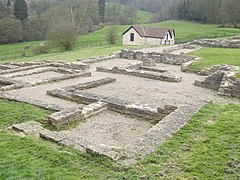Great Witcombe Roman Villa
| Great Witcombe Roman Villa | |
|---|---|

The remains of the villa
|
|
|
Location within Gloucestershire
|
|
| General information | |
| Location |
Gloucestershire grid reference SO899142 |
| Country | United Kingdom |
| Coordinates | 51°49′36″N 2°08′51″W / 51.8267°N 2.1474°WCoordinates: 51°49′36″N 2°08′51″W / 51.8267°N 2.1474°W |
| Construction started | 1st century |
| Demolished | 5th century |
Great Witcombe Roman Villa was a villa built during the Roman occupation of Britain. It is located on a hillside at Great Witcombe, near Gloucester in the English county of Gloucestershire.
The Roman villa at Great Witcombe is thought to have been built during the first century AD, and was probably occupied until the fifth century AD. These date ranges are largely based upon coins found during excavations of the site. The villa itself is sited in an unusual location – the unevenness of the terrain, which was riddled with small streams and natural springs, would seem to render it unsuitable for such a large dwelling. It is thought, however, that these springs would have been harnessed into water features in stylised gardens, and that a cult of water nymphs may have been cultivated around this, although this is supposition. To cope with the difficult terrain, the building itself was constructed on four terraces, cut into the hillside and heavily buttressed, which are still evident on the gallery connecting the two main wings of the house. The architectural design of the villa differs greatly from similar dwellings from the same period, given that the main living quarters were in the large eastern wing, and a long gallery of little function connected this wing with the ‘leisure wing’ where the bath house and temple were located. This layout reflects the evolution of the house over time—the bath house wing was a later expansion—and a consideration of the spatial restrictions of the site.
When the site was first excavated in the 19th century it was reported that parts of the villa were very well preserved. Walls of 6 ft high were documented, some still plastered. The bath house was one of the most complete examples known at the time and several mosaic floors were recorded. Poor conservation techniques and heavy rain have destroyed most of these features.
The site currently consists of the remains of low walls which give a good idea of the general shape of the building. Two parts of the bath house are protected by small sheds, not accessible to the public. Besides its unusual shape, the villa has a few features worth noting, including a bath house and latrine, household shrine and an octagonal room of unknown use.
The latrine is located near the dressing room of the baths. The main drain on the north side was formed of stone and is still evident today. The fittings were removed in the late 4th century, but debris nearby suggests they were originally made of sandstone. The walls were plastered and coloured white with red stripes and patches of pink. The latrine was accessible via a passageway which contained a mosaic floor. Parts of the plaster fragments of one of the walls still remain.
...
Wikipedia

